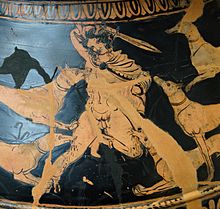Xiphos
Some of this article's listed sources may not be reliable. (June 2009) |


The xiphos (Ancient Greek: ξίφος [ksípʰos]; plural xiphe, Ancient Greek: ξίφη [ksípʰɛː])[1] is a double-edged, one-handed Iron Age straight shortsword used by the ancient Greeks. It was a secondary battlefield weapon for the Greek armies after the dory or javelin. The classic blade was generally about 45–60 cm (18–24 in) long, although the Spartans supposedly preferred to use blades as short as 30 cm (12 in) around the era of the Greco-Persian Wars. The xiphos sometimes has a midrib, and is diamond or lenticular in cross-section. It was a rather light weapon, with a weight around 450 to 900 grams or 1-2 lbs. It was generally hung from a baldric under the left arm.[2] The xiphos was generally used only when the spear was broken, taken by the enemy, or discarded for close combat. Very few xiphe are known to have survived.
The xiphos' leaf-shaped design lent itself to both cutting and thrusting. The origin of the design goes back to the Bronze age; the blade of the xiphos looks almost identical to the blade of the Mycenean naue 2 sword, which itself transitioned from having a blade of bronze into a blade made of iron during the Archaic period. It is likely that the xiphos is the natural evolution of the iron version of the naue 2 but with a more sophisticated handle design.
The early Celtic La Tène short sword, contemporary with the xiphos, had a virtually identical blade design as the xiphos.[citation needed]
The leaf-shaped short swords were not limited to Greece, as mentioned, but can be found throughout Europe in the late Bronze Age under various names.[3]
Myths[]
Contrary to popular belief, no examples of bronze xiphe have been found; researchers lack a clear answer as to where this myth first originated. They speculate it could be caused by a confusion of bronze weapons as xiphe or ornaments. For information regarding Greek weapons during the Bronze Age refer to the Aegean section in Bronze Age sword.
Several whole or partial xiphe blade samples have been found in places such as Olympia, Macedonia and South Italy. All samples found and classified as Xiphe are all made exclusively out of iron. Xiphos-like swords started to appear centuries after typical bronze age designs such as the Naue II and others transitioned from bronze to iron. This fact serves as further evidence that Xiphe were never made out of bronze.
Etymology[]
Stone's Glossary has xiphos being a name used by Homer for a sword. The entry in the book says that the sword had a double-edged blade widest at about two-thirds of its length from the point, and ending in a very long point.[4] The name xiphos apparently means something in the way of "penetrating light" according to researcher and swordsmith Peter Johnsson.[2][dubious ]
The word is attested in Mycenaean Greek Linear B form as
